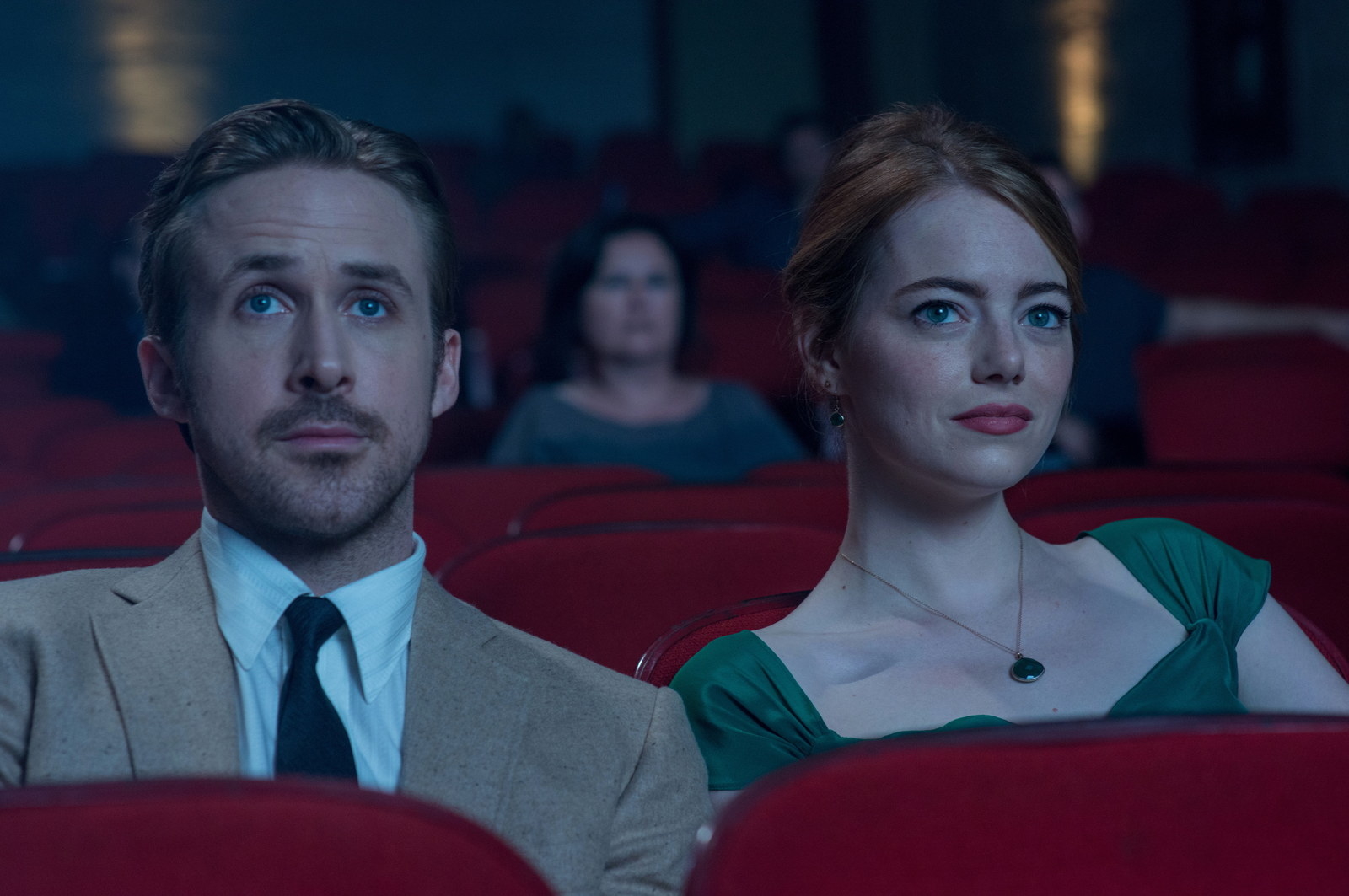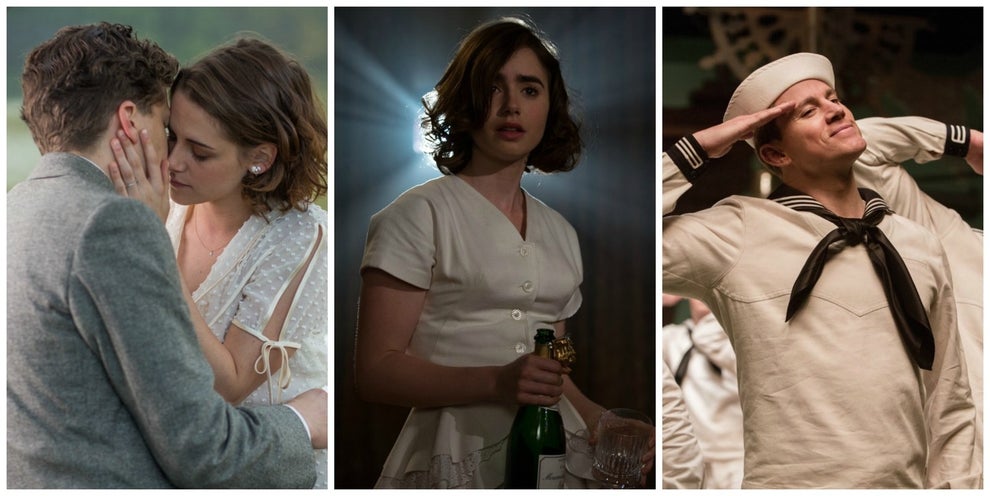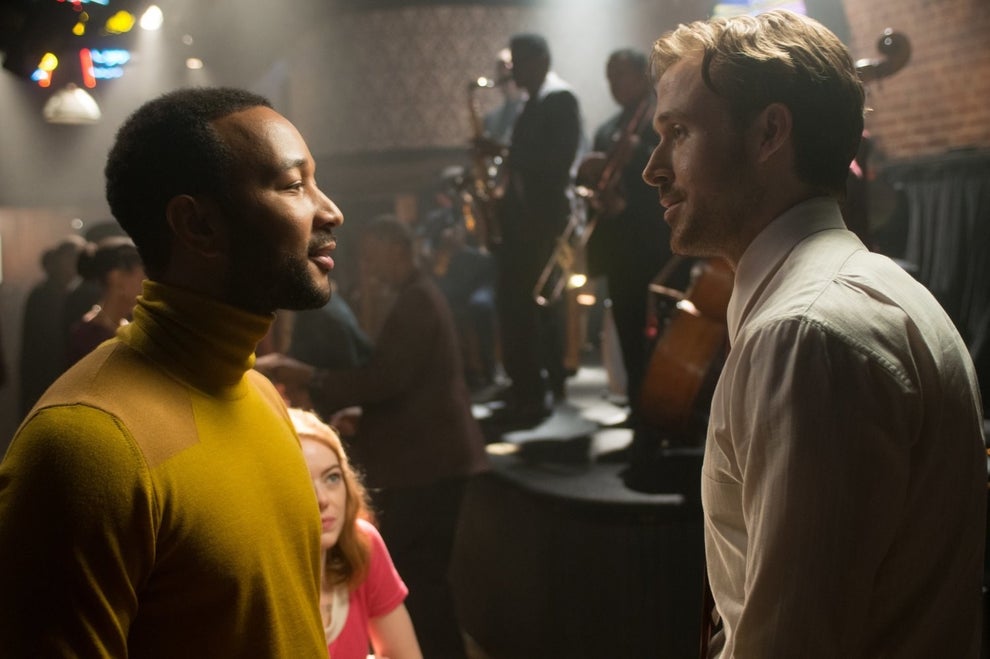
Sebastian (Ryan Gosling) and Mia (Emma Stone) at the movies in La La Land. Dale Robinette / Lionsgate
Nostalgia is more than an emotion for the pair of lovers in La La Land. It’s a belief system, the scaffolding supporting their fragile yearnings for showbiz success, propping them up against an onslaught of present-day indignities. Mia (Emma Stone), an aspiring actor, and Sebastian (Ryan Gosling), a struggling jazz pianist, sleep under posters of Ingrid Bergman and collect piano stools that once allegedly propped up Hoagy Carmichael’s legendary behind, as if these objects have totemic value. They dream in Technicolor, or in glimmering black and white.
Both have their own sacred spaces tucked away in not-always-pretty present-day Los Angeles. There’s the window from Casablanca on the Warner Bros. lot where Mia works, between auditions, as a barista, and there’s the treasured music venue that’s transformed into a combination samba/tapas joint, enraging Sebastian (“Pick one,” he fumes). Their nostalgia goes beyond a reverence for the underappreciated past and into an act of faith — they’re so besotted with eras that ended long before they were born that they hold out hopes for the kind of careers their industries no longer have much interest in fostering.
Mia and Sebastian are just two more would-be artists in the crowd of strivers cluttering the 110-105 interchange in La La Land’s splendid opening scene, that long take in which a musical number erupts out of the tedium of afternoon traffic. They’re two more talented nobodies vying for parts in lousy-looking shows described as “Dangerous Minds meets The O.C.” and taking gigs with costumed ’80s cover bands to pay the rent. But their old-fashioned aspirations and touchstones leave Mia and Sebastian a half step out of sync with everyone around them, making them, La La Land intimates, more romantic and — in a way that should frankly be twee and irritating as hell — more pure.
That La La Land is not irritating as hell, that it is instead confoundingly wonderful (and, OK, a tiny bit twee), is one of those mysteries audiences can contend with months after first seeing it. Maybe it’s because the film reveals itself to be as much about the limits of nostalgia as it is an exercise in it. Damien Chazelle, whose last feature, Whiplash, was a musical of a less conventional sort, obviously has a lot in common with his characters. The 31-year-old writer and director wants to resurrect a form that has mostly faded from use, trying out the song-and-dance music the way someone might try on a vintage outfit.
But bittersweet and bubble-delicate as it might be, La La Land is too present to be a pastiche, filled with allusions to classics like Singin’ in the Rain and The Umbrellas of Cherbourg, but always keeping one foot planted on the grimy LA pavement. As Mia and Sebastian, Stone and Gosling give performances that are deliberately a little imperfect. Their characters have to reckon with compromises when chasing their impossible, and then maybe not so impossible after all, ambitions. As disappointment and bitterness slowly seep into the film, the effervescence drains out, only to return in full force in the epilogue imagining an alternate history that dissipates like mist. It’s a privilege, the nostalgia Mia and Sebastian feel and ultimately use as a means of personal branding, but it’s also too shallow a solace to keep reality at bay.
When La La Land wins the Oscar for Best Picture, as it seems very likely to, it will look, from afar, like a navel-gazing choice to top off the chaotic, divided misery that was 2016. What’s safer and more predictable than the movie industry’s love of movies about the movie industry? But to treat La La Land as the Oscar equivalent of a “no comment” would be to do it a disservice. It’s a bittersweet answer to a year in which nostalgia turned on us. It turned on us in minor ways, in how cynically and inauspiciously it was used to leverage sequels — Bridget Jones’s Baby, Zoolander 2, Independence Day: Resurgence — that no one seemed to want. And it turned on us in large, frightening ways, in the war cry of “Make America great again,” which brought with it the question of when the country was last “great,” and for whom.
The complications of nostalgia for a simpler, nattier dressed, and, incidentally, more exclusionary and oppressive time could be seen in the multiple movies set in the film industry’s past that big-name directors put out in the months before La La Land reached theaters. Each of three — Woody Allen’s Café Society, Warren Beatty’s Rules Don’t Apply, and the Coen brothers’ Hail, Caesar! — takes great pleasure in the trappings of vintage Hollywood, and each pairs that pleasure with a different degree of acknowledgment of their time periods’ respective shittiness.
In the inert Café Society, set in a golden-toned 1930s as seen through the eyes of the Bronx-born Los Angeles transplant Bobby Dorfman (Jesse Eisenberg), there’s no acknowledgment at all. The past has always had more allure than the present for Allen, and Café Society isn’t a film in which that fact is mediated by any self-awareness — there’s a tranquilizing quality to its incurious beauty. When California eventually lets Bobby, his stand-in, down, it’s not for reasons that are anything other than personal — he’s another Allen protagonist who finds the West Coast wanting.
Bobby (Jesse Eisenberg) and Vonnie (Kristen Stewart) in Café Society; Marla Mabrey (Lily Collins) in Rules Don’t Apply; Burt Gurney (Channing Tatum) in Hail, Caesar!. Amazon Studios; Twentieth Century Fox Film Corporation; Alison Cohen Rosa / Universal Pictures
More interesting but more muddled in its take on an early showbiz era is the strange, arrhythmic Rules Don’t Apply. Beatty’s film is a tragedy in the form of a screwball comedy about driver Frank Forbes (Alden Ehrenreich) and aspiring actor Marla Mabrey (Lily Collins), who meet in the orbit of Howard Hughes (Beatty) in the ’50s. It’s about being at the beck and call of a gradually deteriorating man everyone’s willfully pretending is just eccentric — and in Marla’s case, it’s about being one of a collection of pretty would-be starlets being kept, corralled, and occasionally summoned like expensive pets.
Marla, who starts a forbidden romance with Frank, gets treated with great cruelty, and yet the film can’t find it in itself to be cutting — it is curiously light and sunny until its melancholy coda. Rules Don’t Apply should feel like a satire about our national tendency (still going strong!) to lionize billionaire businessmen as godlike, but Beatty seems to be as fascinated by Hughes as the eventual lovers his story eclipses.
The best of the trio is the Coens’ giddy Hail, Caesar!, which is set around the same time as Rules Don’t Apply. It doesn’t just acknowledge the gap between public image and messy, sometimes ugly truth in its studio setting, it turns it into the film’s central joke. Fixer Eddie Mannix (Josh Brolin) has a full-time job covering up the fact that his studio’s bathing beauty is unwed and pregnant and that its biggest star is heteroflexible.
Up-and-comers Hobie Doyle (also Alden Ehrenreich) and Carlotta Valdez (Verónica Osorio) play along with the roles of period drama stars and ethnic stereotypes assigned to them by executives. The Coens were rightfully criticized for the terrible answer they gave when asked about their film’s pervasive whiteness, but in the case of Hail, Caesar!, whiteness is part of its point. It’s a wry but cheerful portrayal of the birthplace of dreams as a manufactured, unrepresentative, barely held together lie.
Keith (John Legend) and Sebastian in La La Land. Dale Robinette / Lionsgate
Whiteness is part of the point of La La Land as well — it is, after all, a privilege of whiteness to see yourself so easily in the stars of the studio golden age, as Mia does, and to imagine yourself among them or as carrying on in their tradition. It’s a privilege of whiteness to feel such an unabashed sense of ownership over a genre of music as fundamentally grounded in the black experience as jazz the way Sebastian does. Sebastian is gifted — it’s why Keith (John Legend), whose band is on the rise, hires him as a keyboardist, despite calling the self-appointed traditionalist a “pain in the ass” and asking him, “How are you going to save jazz if no one’s listening?” Keith sees jazz as alive and adapting, whereas for Sebastian it’s frozen in the past, bound by rules about the right and wrong ways to go about it.
Keith’s right, but it’s Sebastian and Mia that the movie is about. They are passionate about their dreams, but what allows them to fulfill those fantasies is ultimately their ability to hawk nostalgia, to leverage it. That’s not the exclusive domain of whiteness, but it has certainly been a specialty of it, not just in MAGA hats but in the aesthetics of hipster Brooklyn and Silver Lake and everywhere else that can support a straight razor barbershop/bar. Mia nabs her big break, a movie shooting in Paris (Paris!), by telling a story about growing up idolizing her aunt and inheriting her desires for a bold, throwback artist’s life, turning her memories into a message more universal, a plea on behalf of dreamers. As a reward, she doesn’t have to fit herself into some lesser commercial project — she becomes the film, the role being shaped around her.
Sebastian, too, gets the jazz club he always longed for, and — despite his total lack of commercial sense — it’s thriving, his hardline purism having been interpreted into something that seems hip. It’s the kind of place that doesn’t try to lure people off the street with its quiet retro appeal, and yet manages to anyway. It looks cool, Sebastian’s venue, and it sounds charming, Mia’s movie. Like La La Land itself, these projects are creations of a lucky and entitled collection of people for whom nostalgia for the past reads not as affectation but as authenticity. That they are so lovable in the face of their unconscious advantages speaks to the talent of the leads, to Chazelle’s measured self-awareness, and to the sincerity of the film’s joy. Or chalk it up to the magic of the movies in which La La Land so fervently believes, and which it peddles so convincingly you may not even notice what’s being sold.




